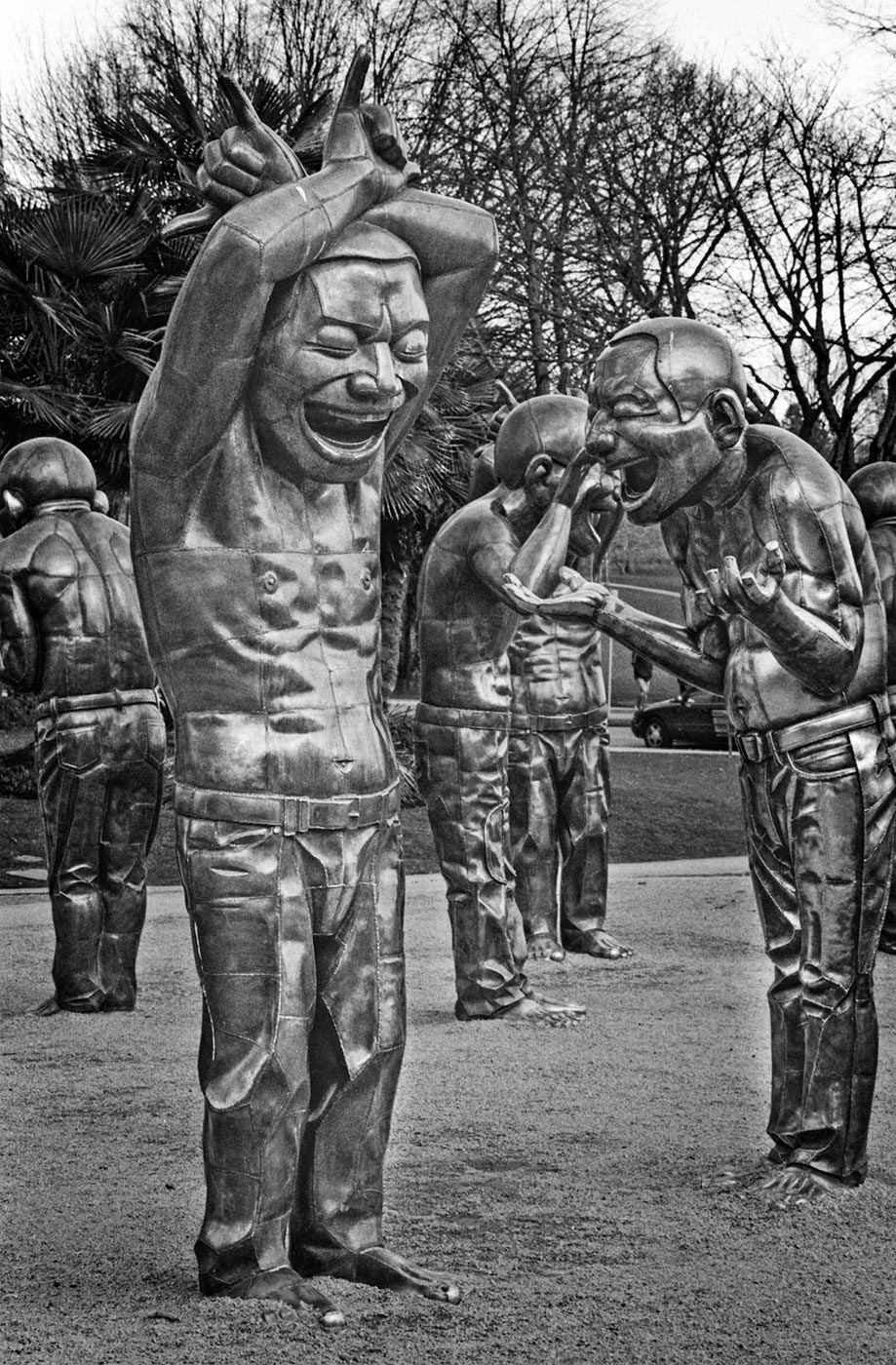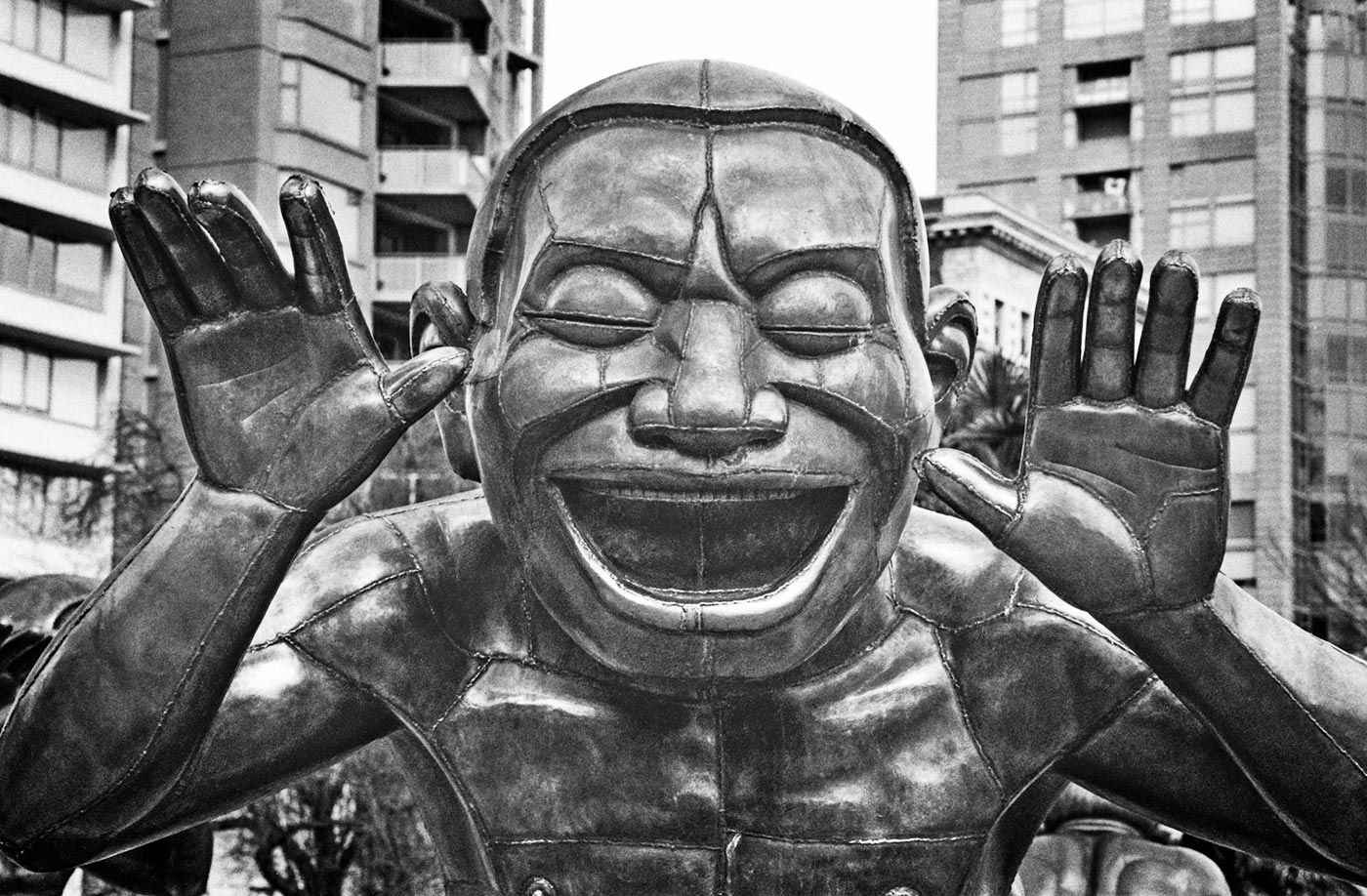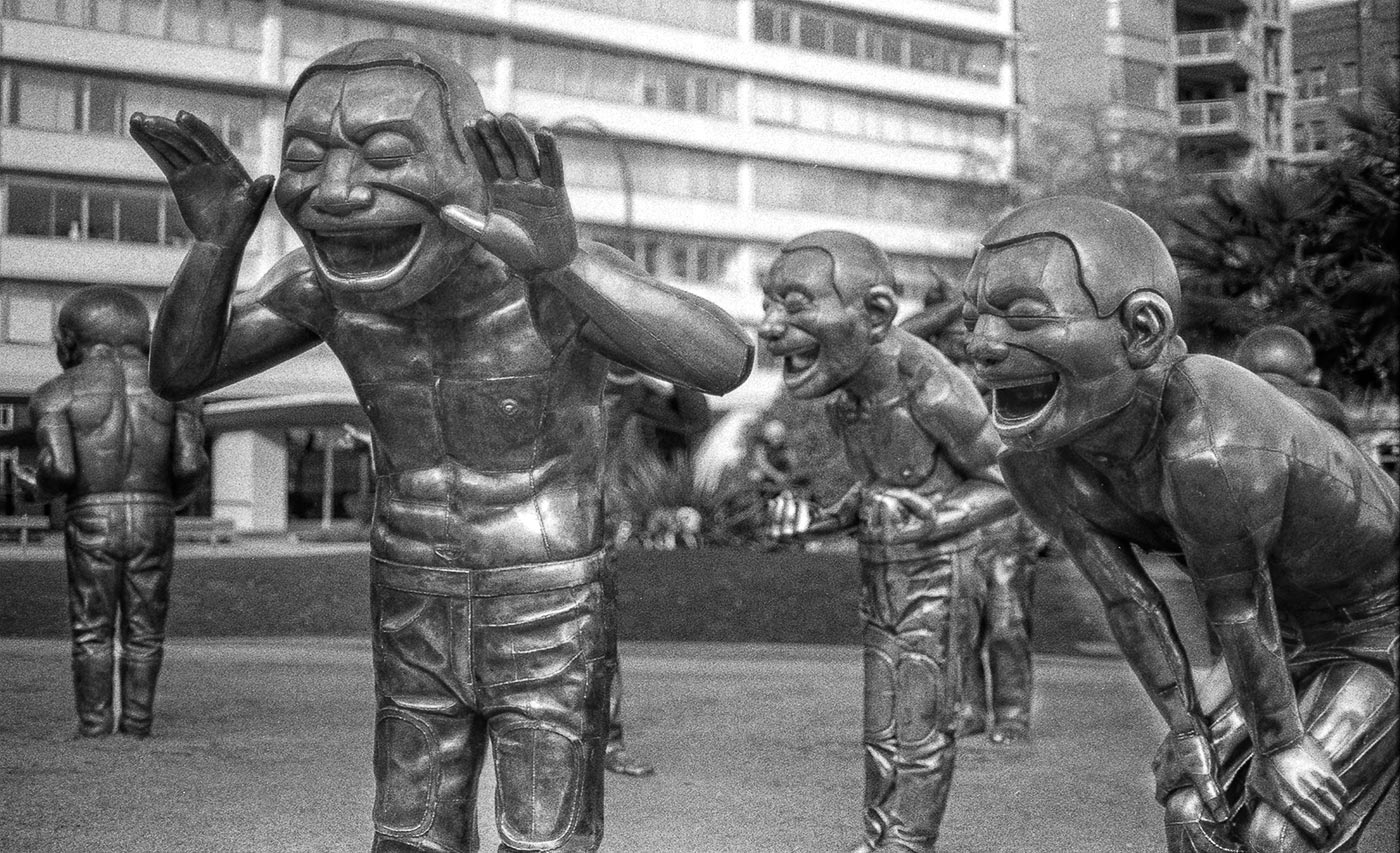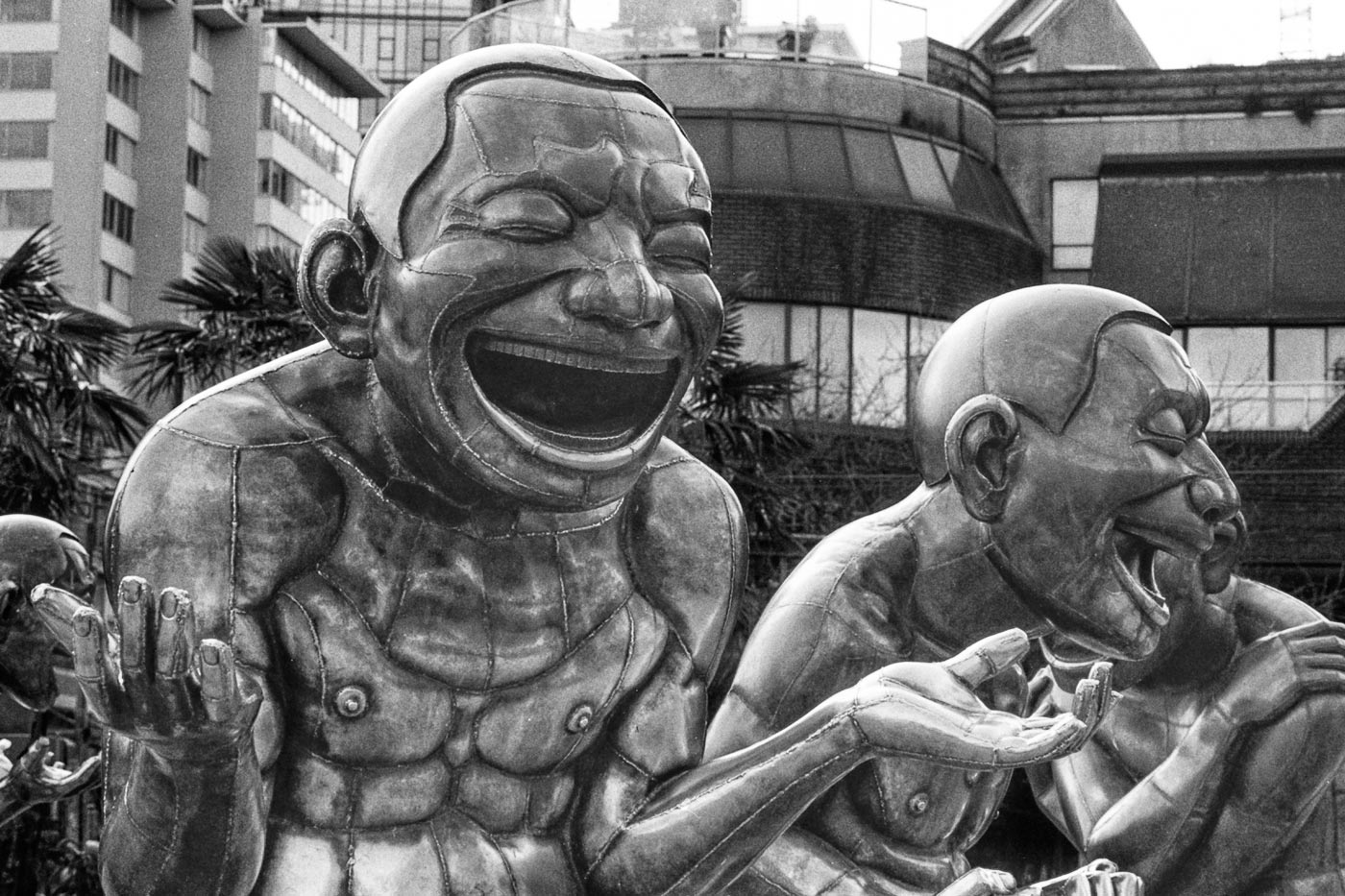Every so often I feel like shooting a roll of film. I know it is an affliction that seems mad to many but I enjoy it. It is always fun and it takes me back to my early days in photography. Now, black and white film does not suit every subject and one must chose carefully. I am fortunate in that my collection of old Canon cameras makes choosing the right equipment easy. I wish I had the same range of cameras and lenses available for my modern digital cameras!
The other day I decided to take one of my venerable F-1’s out with an FD 50mm f/1.4 S.S.C. for a walk with a roll of Ilford HP5. It was a cloudy bright day and so the film’s speed would be an advantage. But what to shoot?
Well, lets back track a little bit. In Vancouver we have a group called the Biennial Foundation. They are a non-profit organization that tries to bring world class outdoor art to Vancouver every two years for exhibition. It is a wonderful idea and their choices often spark great public debate.
In 2009 thru 2011 they arranged for the exhibition of a work called A-Maze-Ing Laughter by Chinese artist Yue Minjun from Bejing. This is a striking bronze sculpture of 14 3 meter tall men in various poses laughing uncontrollably. The work was displayed across the road from English Bay in downtown Vancouver. It quickly brought strong public reaction both for an against the piece(s) and it stirred considerable discussion in the arts community.
I remember not liking it at first but when it was purchased by public subscription in 2012 for permanent display in Vancouver I was pleased. It was certainly unique, controversial, and it was in a lovely setting on English Bay at the top of Denman Street.
Now back to my film shoot. I had not taken photos of this art work and I felt that the day, the lighting and the film would work well together so off I went. Some of my images from that day are posted here.
I spent the better part of a morning by English Bay taking pictures of these sculptures. Looking at the results of my efforts I began musing about making a large print of one of the images and it occurred to me that there may be copyright problems with displaying such a print in public so I did a little searching on line. I found that who owns an image is very complicated. And very interesting.
I have no intention of setting out a treatise on the law of artistic copyright. You can actually find such a discussion on line and I have set out some suggestions for you below. But lets consider the issues with a very broad general discussion.
It seems that when an artist creates a work he/she has the exclusive right to reproduce that work in any manner. There are some exceptions in which others may reproduce images of the work such as putting an image of it in a critique or discussion of the work like we are doing here or keeping an image for private use. The artist can sell his rights when he sells the work or he can even keep his rights and sell the art. It can get very complicated.
Where the work is displayed and who owns it is also very complex. Public art such as this is generally OK to photograph without running into copyright problems but if that work is in the lobby of a privately owned building it is generally covered by copyright and cannot be used commercially without permission. If I hang a photograph of mine in a public exhibition, it is usually protected. But notice the words “usually”, “generally”, “complex”. Every case depends on its own circumstances.
In one famous case a photographer doing a commercial shoot for a corporate client posed his models in front of a piece of art on public view but the artist had kept his copyright. As the art was featured in the background and was an integral part of the photograph a court held that the copyright existed and the commercial use of the photographs infringed on the rights of the artist. He had to be compensated.
Street photography is an area that can be complex. If I shoot a street scene in which there are people we have competing rights in play. The photographer has a right to take pictures in the street. But, people have certain rights to privacy. And it all boils down to whether the people are the subject of the image or whether they are simply elements in a street scene. It depends on how the judge views it. That is why model releases are generally required by clients for any commercial use of a street scene in which people are recognizable. The releases may not be necessary but you won’t know until after the judge gives his verdict. So why take a chance. Litigation is risky.
If I photograph a sculpture that is subject to copyright, my photograph is subject to my copyright but the original artist also has rights to the photograph because it is a reproduction of his work. You can see how quickly this can become very complicated.
But this much I think I know: Public art in a public space is fair game. And in a little blog like this that discusses photography and art almost any photographs are acceptable. Almost any.
As a matter of courtesy, the artist of any recognizable artwork should be acknowledged, as I have done above. When I know how to contact the artist I drop him an e-mail and tell him of my use of his work. I do this with websites as well when I use other peoples photos in my website.
And if you are going to use your work for commercial gain, do your home work. If there is a lot of money involved, after you have done your homework, talk to your copyright lawyer.
Postscript
If you want to follow up and learn more I suggest you start by searching for something like “photograph of sculpture copyright” or “art copyright” in your favorite search engine. But be prepared to spend some time reading. And remember that every case depends on its particular facts. Read several articles, the more the better, to really get a handle on the subject. And if you are working with images that involve commercial use, you really should talk to a copyright lawyer after you have spent several hours reading on the internet.
Here are a few articles I found to get you started, in no particular order:
|
Copyright And Taking Pictures Of Sculptures |
http://cjam.info/en/copyright-and-taking-pictures-of-sculptures-2/ |
|
Who Owns the Copyright |
https://alj.artrepreneur.com/copyright-public-art/ |
|
Fair Use of Copyright Images in Your Blog |
https://alj.artrepreneur.com/fair-blogging-bloggers-copyrighted-images/ |
|
A guide to copyright |
https://www.ic.gc.ca/eic/site/cipointernet-internetopic.nsf/eng/h_wr02281.html |
|
Is Street Art and Graffiti Copyright Protected? |
http://www.froeselaw.com/2018/03/17/is-street-art-and-graffiti-copyright-protected/ |
|
Legal Pitfalls in Taking or Using Photographs of Copyright Material, Trademarks and People |
https://www.wipo.int/export/sites/www/sme/en/documents/pdf/ip_photography.pdf |
|
Commons:Copyright rules by subject matter |
https://commons.wikimedia.org/wiki/Commons:Copyright_rules_by_subject_matter |
|
Photograph of Sculpture Is Not a Fair Use |
https://www.photoattorney.com/photograph-of-sculpture-not-a-fair-use/ |
|
copyright and privacy in photography |
https://cippic.ca/en/FAQ/Photography_Law |
|
Photography and Copyright Law |
https://blog.kenkaminesky.com/photography-copyright-and-the-law/ |
|
Photo Reproduction of Artworks |
https://www.artslaw.com.au/articles/entry/photo-reproduction-of-artworks/ |
|
What Happens When You Photograph Copyrighted Work? |
https://www.pixsy.com/photograph_copyrighted_work/ |







